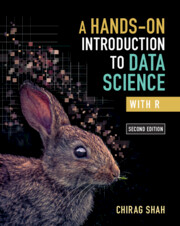Refine search
Actions for selected content:
1835 results in Knowledge Management, Databases and Data Mining

A Hands-On Introduction to Data Science with Python
- Coming soon
-
- Expected online publication date:
- January 2026
- Print publication:
- 22 January 2026
-
- Textbook
- Export citation

A Hands-On Introduction to Data Science with R
- Coming soon
-
- Expected online publication date:
- January 2026
- Print publication:
- 22 January 2026
-
- Textbook
- Export citation
Copyright page
-
- Book:
- Insight-Driven Problem Solving
- Published online:
- 21 October 2025
- Print publication:
- 30 October 2025, pp iv-iv
-
- Chapter
- Export citation
2 - Artificial Intelligence and Machine Learning
-
- Book:
- Insight-Driven Problem Solving
- Published online:
- 21 October 2025
- Print publication:
- 30 October 2025, pp 53-110
-
- Chapter
- Export citation
Index
-
- Book:
- Insight-Driven Problem Solving
- Published online:
- 21 October 2025
- Print publication:
- 30 October 2025, pp 313-322
-
- Chapter
- Export citation
Introduction
-
- Book:
- Insight-Driven Problem Solving
- Published online:
- 21 October 2025
- Print publication:
- 30 October 2025, pp 1-11
-
- Chapter
-
- You have access
- HTML
- Export citation
6 - Dynamic Programming and Sequential Decision-Making
-
- Book:
- Insight-Driven Problem Solving
- Published online:
- 21 October 2025
- Print publication:
- 30 October 2025, pp 188-206
-
- Chapter
- Export citation
Notes
-
- Book:
- Insight-Driven Problem Solving
- Published online:
- 21 October 2025
- Print publication:
- 30 October 2025, pp 281-296
-
- Chapter
- Export citation
4 - Game Theory and Mechanism Design
-
- Book:
- Insight-Driven Problem Solving
- Published online:
- 21 October 2025
- Print publication:
- 30 October 2025, pp 140-166
-
- Chapter
- Export citation
8 - Graph Theory, Combinatorial Optimization, and Supply Chains
-
- Book:
- Insight-Driven Problem Solving
- Published online:
- 21 October 2025
- Print publication:
- 30 October 2025, pp 250-278
-
- Chapter
- Export citation
3 - Queueing Theory and Resource Allocation
-
- Book:
- Insight-Driven Problem Solving
- Published online:
- 21 October 2025
- Print publication:
- 30 October 2025, pp 111-139
-
- Chapter
- Export citation
7 - Data Analysis
-
- Book:
- Insight-Driven Problem Solving
- Published online:
- 21 October 2025
- Print publication:
- 30 October 2025, pp 207-249
-
- Chapter
- Export citation
Preface
-
- Book:
- Insight-Driven Problem Solving
- Published online:
- 21 October 2025
- Print publication:
- 30 October 2025, pp xi-xiv
-
- Chapter
- Export citation
Dedication
-
- Book:
- Insight-Driven Problem Solving
- Published online:
- 21 October 2025
- Print publication:
- 30 October 2025, pp v-vi
-
- Chapter
- Export citation
1 - The Big Picture of Analytics Science
-
- Book:
- Insight-Driven Problem Solving
- Published online:
- 21 October 2025
- Print publication:
- 30 October 2025, pp 12-52
-
- Chapter
- Export citation
Contents
-
- Book:
- Insight-Driven Problem Solving
- Published online:
- 21 October 2025
- Print publication:
- 30 October 2025, pp vii-x
-
- Chapter
- Export citation
References
-
- Book:
- Insight-Driven Problem Solving
- Published online:
- 21 October 2025
- Print publication:
- 30 October 2025, pp 297-312
-
- Chapter
- Export citation
5 - Linear and Nonlinear Mathematical Programming
-
- Book:
- Insight-Driven Problem Solving
- Published online:
- 21 October 2025
- Print publication:
- 30 October 2025, pp 167-187
-
- Chapter
- Export citation
Acknowledgments
-
- Book:
- Insight-Driven Problem Solving
- Published online:
- 21 October 2025
- Print publication:
- 30 October 2025, pp 279-280
-
- Chapter
- Export citation

Insight-Driven Problem Solving
- Analytics Science to Improve the World
-
- Published online:
- 21 October 2025
- Print publication:
- 30 October 2025
